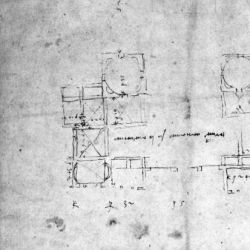The Baths of Trajan Decius — or of Philip the Arab?
Palladio’s sketch plan
Page 4

Another important source of information about the Baths of Decius is a freehand plan sketched by the Renaissance architect Andrea Palladio (1508-80), probably on the occasion of his last trip to Rome in 1554.27 The bath complex was in ruins when Palladio saw it but the plan and dimensions of the structure were at least partly discernible. Palladio’s sketch plan shows two symmetrical ranges of rooms. Rooms E, E’, F and F’ (following La Follette’s labelling) open through column screens onto the SW façade. D, D’, C, and C’ are rectangular rooms roofed with cross vaults. Room B is also shown as cross-vaulted, while its counterpart B’ appears to carry a barrel vault, perhaps the result of a later rebuilding. The two large rooms A and A’ were square on the exterior, circular inside, and presumably domed. These were probably cold bathing rooms.28 Each was provided with four semi-circular niches which may have held basins or small plunge baths. The measurements recorded in Palladio’s hand on the sketch indicate that the width of the preserved portion of the SW façade was slightly more than 70 m and the length from the SW façade to the NE walls of rooms A and A’ was about 44 m.29
27 The plan is preserved in the Royal Institute of British Architects in London, catalogued as RIBA XV/11v. For the date see La Follette (1994) 33-34 and La Follette (1993) 196-98.
28 Identical rotundas are found in the unheated area of the baths of Trajan: Nielsen I, 55.
29 La Follette (1994) 34-36.